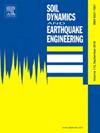列车-轨道-隧道耦合微分正交有限元动力学模型的一种有效求解方法
IF 4.2
2区 工程技术
Q1 ENGINEERING, GEOLOGICAL
引用次数: 0
摘要
针对列车-轨道-隧道耦合系统的复杂性,采用p收敛和h收敛的微分正交有限元(DQFEM)建立了列车-轨道-隧道耦合系统的精细化动力学模型。针对列车-轨道-隧道系统计算效率低的问题,本文对循环计算方法进行改进,采用线性叠加法将列车-轨道系统分解为车辆-轨道系统。同时,将基础设施以离散形式表示为Green函数,并通过界面相互作用力将基础设施与列车轨道系统耦合。通过与时域和频域有限元模型的比较,验证了基于DQFEM的列车-轨道-隧道耦合动力模型的可靠性。通过与传统求解方法的比较,验证了所提求解方法的准确性和高效性。在数值算例中,详细分析了列车-轨道-隧道的动力响应分布以及隔振轨道的影响。所得结论对地铁系统轨道结构的减振设计具有实用价值。本文章由计算机程序翻译,如有差异,请以英文原文为准。
An efficient solution method for train-track-tunnel coupled differential quadrature finite element dynamic model
Aiming at the complexity of train-track-tunnel system, differential quadrature finite element (DQFEM) with both P-convergence and H-convergence is used to establish a refined dynamic model of train-track-tunnel coupled system. To solve the problem of low calculation efficiency of train-track-tunnel system, this paper improves the cyclic calculation method and adopts linear superposition method to decompose the train-track system into vehicle-track system. At the same time, the infrastructure is expressed the as Green function in discrete form, and infrastructure is coupled with the train-track system by the interface interaction force. The reliability of the proposed train-track-tunnel coupled dynamic model based on DQFEM is verified by comparing with FEM model from in time- and frequency-domain. Furthermore, by comparing with the traditional solution method, the accuracy and efficiency of the proposed solution method is demonstrated. In the numerical example, the distribution of the train-track-tunnel dynamic response and the influence of the vibration isolation track is analyzed in detail. The conclusions have practical value for the design of the railway structure with vibration reduction in subway system.
求助全文
通过发布文献求助,成功后即可免费获取论文全文。
去求助
来源期刊

Soil Dynamics and Earthquake Engineering
工程技术-地球科学综合
CiteScore
7.50
自引率
15.00%
发文量
446
审稿时长
8 months
期刊介绍:
The journal aims to encourage and enhance the role of mechanics and other disciplines as they relate to earthquake engineering by providing opportunities for the publication of the work of applied mathematicians, engineers and other applied scientists involved in solving problems closely related to the field of earthquake engineering and geotechnical earthquake engineering.
Emphasis is placed on new concepts and techniques, but case histories will also be published if they enhance the presentation and understanding of new technical concepts.
 求助内容:
求助内容: 应助结果提醒方式:
应助结果提醒方式:


